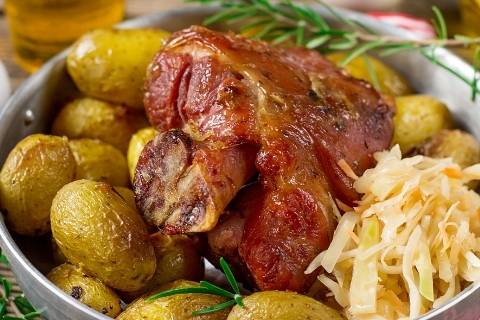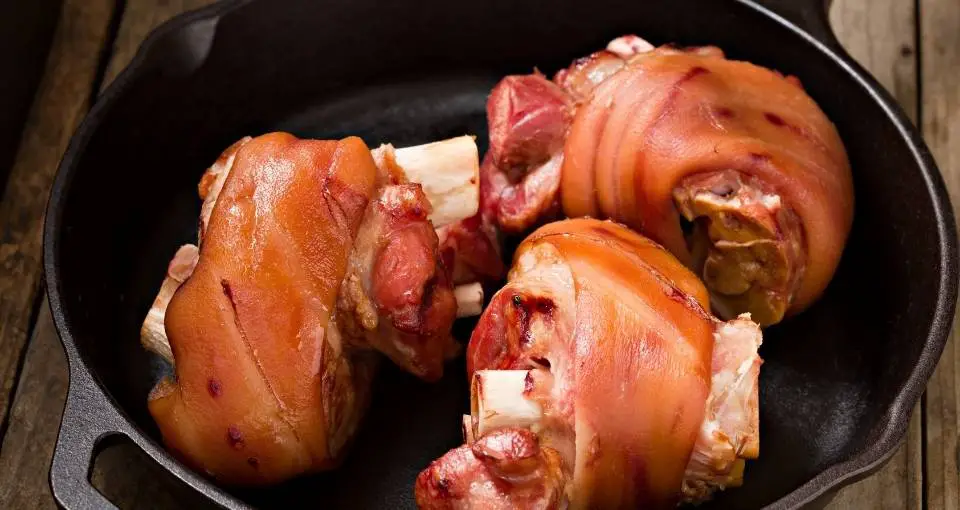So you are in the grocery store and you are fetching all the ingredients for this delicious new recipe you can’t wait to try. This particular recipe calls for pork hocks but as you roll up to the meat section you realize that they only have ham hocks. Ham is pork, pork is ham, same-same right? Well, not exactly.
The hock of a pig basically is the “ankle” of a pig but there is a difference between ham hocks and pork hocks. While they are both ankles, ham hocks are from the rear ankles and pork hocks can come from the front or the rear pig ankles.
Where the hock comes from is only a minor difference though. The true distinction between ham hocks and pork hocks are as follows.
What Is The Difference Between a Pork Hock and a Ham Hock?
Tip: Ham hocks can also be referred to as “pork knuckle”.
Ham Hocks
Ham hocks are cured or smoked. If you think of any ham, it is always smoked or cured to preserve the meat then reheated to a specific internal temperature of 165 degrees. Yes, typically ham hocks are from the rear ankles of the pig but the term “ham” refers to the curing process.
Pork Hocks
Pork hocks can be from either the front or back of the pig but how it differs from a ham hock is that it is raw, so they will not be cured or smoked.
Pork hocks tend to be a bit more versatile throughout cuisines as they do not add any additional flavors to a recipe through salt or smoke.
To keep is simple, ham hocks are cured and pork hocks are raw or uncooked. It’s that simple but how do they differ in recipe preparation. This leads us back to the opening paragraph question, can they be swapped. In short, no.
Since ham hocks are cured through a salt process or smoked they are usually used for flavoring a recipe with the option to add the meat back or keep it separate.
For the most part, hocks are bone-in so that means the ham hock will go through the cooking process in a soup or stew then removed at the end, at which point you could pick the meat off and add back or reserve it for your own enjoyment.

A couple of examples are, potato and ham hock soup and ham hock and white bean stew. A good use of a ham hock is in split pea and ham soup where you would pick the meat off and add it back to the soup. It is a good rule of thumb to cook ham hocks about 4-5 hours.
Pork hocks are different in that they are uncooked. This allows for more applications and can be the star of the dish. Cooking time is anywhere from 2-4 hours. They can be roasted, braised, or boiled.
These are popular in Germany where they are part of a popular dish at Octoberfest called “Schweinshaxe”, a dish from the southern Bavarian section. Schweinshaxe is known as a roasted pork hock while a northern dish called “Eisbein”, is a boiled version of this traditional German dish.
Pork hocks are also popular in Chinese cuisine and a dish called Ti Pang is popular during the Chinese New Year celebration that brings luck and longevity.
Do Smoked Ham Hocks Need to be Refrigerated?
Now that you know the difference and you have your ham hocks or pork hock, how should it be stored?
Pork hocks, since they are uncooked or raw should be treated as such, refrigerate or freeze. Check the date on the package and use with in a couple of days of the packing date or freeze for later use.
It is the smoked ham hock or cured ham hock that comes into question. Some may say since it is cured or smoked that it may not need to be refrigerated.
All meat needs to be refrigerated. While it is true that smoked meat has low moisture content that gives it a long shelf life, it is still susceptible to bacterial contamination so please refrigerate.
Now it will last 2 weeks to 2 months in the refrigerator but keep an eye on it.
Smoked ham hocks can be frozen but since they have been “prepared” already they will break down faster in the freezer so should be used within 6 months from the freezer.
Both ham hocks and pork hocks are unique in their use despite being from the ankles of the pig.
Originally the hocks were used in recipes since they were the lower quality cut of meat and allowed it to be more affordable in everyday cooking.
Hocks are enjoyed throughout the world for their protein and flavor. Having said that, it is important to know the difference between a ham hock and a pork hock. Either way, enjoy the “hock” out of your dinner!
Do You Leave Skin on Ham Hock?
Typically the skin is left on the hock, as it does render and release a lot of flavor. Especially if you are using the ham hock to make a soup.
One thing that you can do is score the skin rind before roasting. Scoring the involves slicing several lines across the pork skin. The reason for doing this is to allow fat to escape and allowing the rind to crisp up.
What you end up with after scoring the pork rind is called crackling or rind. Pork rinds are actually made from skin. The kind you want is called crackling and you can further bake these pieces to get a very crispy topping for your meal.

Can You Substitute Bacon for Ham Hocks?
Bacon is a great substitute to use when needed in place of a ham hock. You want to go with a smoked bacon. You may need to add in extra salt or even use bacon grease to get extra fat rendering that would otherwise come from the ham hock.
Also if you plan to use bacon as a substitute for example with a baked bean recipe. Partially cook the bacon first, then when you add in your bacon later there is still rendering to be had. Which will allow the bacon fat to add additional flavor as it renders further.


Is there anyway to buy smoked pork hocks, (only hock available on this mountain) and somehow cure them into ham hocks. These smoked pork hocks are dreadful for my ham hocks and Lima beans, and though not positively flavorful, they add a bad taste.